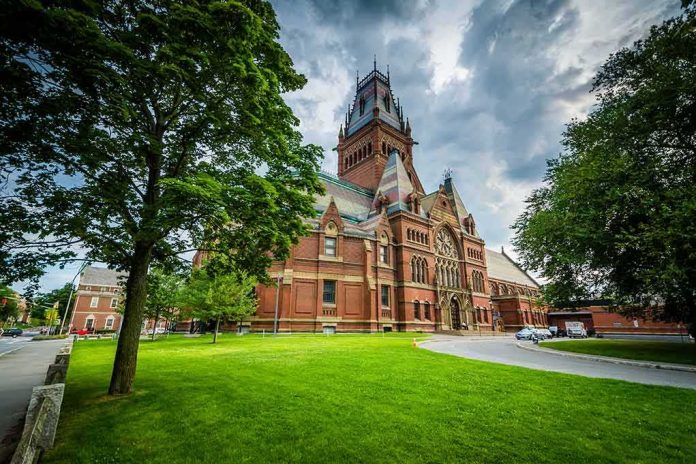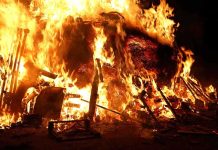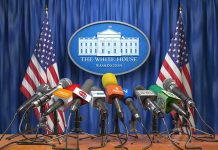
Two young men detonated a firework inside Harvard Medical School’s neurobiology building, exposing the unnerving fragility of elite research security and forcing federal authorities to treat a “prank” as a major crime.
Story Snapshot
- Explosion rocks a sensitive Harvard research building, but causes no injuries or major damage.
- Suspects, unaffiliated with Harvard, charged federally for a conspiracy involving a consumer firework.
- Incident intensifies scrutiny of campus safety and the risks of unauthorized access during high-traffic events.
- Law enforcement credits surveillance and public tips for the rapid arrests; the motive remains unclear.
Harvard’s Goldenson Building Breached by Outsiders
The Goldenson Building at Harvard Medical School, a hub of neurobiology research, became the unlikely scene of a federal crime at 3 a.m. on November 2, 2025. Two masked individuals, later identified as Logan David Patterson and Dominick Frank Cardoza, infiltrated the laboratory after a night of Halloween revelry at neighboring colleges. Their weapon was not a sophisticated bomb, but a common Roman candle firework, set off in a locker and triggering a blast that jolted the heart of one of the world’s leading biomedical institutions. The explosion, while resulting in only minor hallway damage and no injuries, immediately prompted a lockdown, a federal investigation, and a wave of anxiety across campus.
Surveillance footage, quickly scoured by the Harvard University Police Department and the Boston Fire Department’s arson unit, captured the suspects’ approach and hasty departure. Authorities acted decisively. Within 48 hours, the FBI and Boston police arrested Patterson and Cardoza, both of whom had no affiliation with Harvard. The duo’s decision to set off the firework inside a research facility, rather than in the open or during a party, set this incident apart from typical campus pranks or vandalism. Their actions forced a federal response, as the damaged building receives federal funds and houses sensitive equipment and scientific materials, raising the specter of what could have been a catastrophic loss for medical research.
Federal Charges and the Weight of Intent
Patterson and Cardoza faced immediate federal charges—conspiracy to damage a building by means of an explosive—underscoring the seriousness with which authorities viewed the act. Prosecutors and FBI officials made clear that the use of a consumer firework inside a laboratory was not dismissed as a harmless prank. FBI Special Agent Ted Docks stated bluntly that the incident was “not some harmless college prank” but a crime that “could have caused casualties.” The U.S. Attorney for Massachusetts, Leah Belaire Foley, echoed this sentiment, emphasizing the deliberate nature of the act and the ongoing investigation into the suspects’ motives and procurement of the firework. The lack of a disclosed motive left the public speculating: was this a reckless impulse, a dare, or something more sinister? The absence of political or ideological motivation distinguished the case from more calculated attacks, but the consequences—potential harm to critical research infrastructure—remained grave.
The Goldenson Building reopened within days, with Harvard administration seeking to reassure students and faculty about safety and the minimal physical impact. Yet beneath the calm, the incident catalyzed a broader reckoning with campus security. Research institutions across the country quietly reviewed their own access protocols, alarmed by how easily outsiders could penetrate sensitive spaces, even if only with fireworks. The case’s federal dimension set a precedent: intent and context, not just the outcome, would drive prosecutorial decisions for attacks on federally funded research facilities.
Campus Vulnerability and Law Enforcement’s Response
The timing and setting amplified the sense of vulnerability. Halloween, a period of heightened activity and outsider presence, created a chaotic backdrop for the incident. The suspects reportedly moved between parties at the Wentworth Institute of Technology before targeting Harvard, a decision that exposed the porousness of campus boundaries in a city dense with academic institutions. Law enforcement’s rapid response relied on extensive surveillance infrastructure and public cooperation—surveillance images released to the media generated tips that led directly to the suspects’ identification and arrest. The speed of the investigation reassured the campus community, but also highlighted the critical role of vigilance and technology in modern campus security.
Public reactions ranged from relief to unease. Some commentators downplayed the incident as reckless endangerment by young adults, while others warned that the outcome could have been tragic if more volatile materials were involved. Security experts noted the unusual choice of a research facility as the target, and the broader risks posed by even unsophisticated devices in environments housing dangerous chemicals, expensive equipment, and irreplaceable data. The Harvard case now serves as a touchstone for discussions about campus vulnerability, the legal boundaries between mischief and crime, and the fragile intersection of open academic environments and public safety.
Lasting Impact and Lessons for Research Institutions
Short-term, the explosion disrupted research and forced a review of visitor access policies. Long-term, it is likely to drive tighter campus security, stricter enforcement of identification protocols, and fresh attention to emergency preparedness in research settings. The suspects, facing serious federal charges, serve as a cautionary tale about the consequences of impulsive or thoughtless actions in an era where security threats are never far from memory. The broader Boston academic community, already accustomed to heightened vigilance, may see more cooperation between universities and law enforcement, especially during high-traffic events like Halloween.
The incident’s limited physical damage belies its symbolic weight. In a world where the line between youthful stupidity and criminal intent is blurred by circumstance, the Harvard Medical School explosion reminds us that prestige and purpose offer no immunity from risk, and that even the most elite institutions must continuously defend the boundaries of their sanctuaries of knowledge.
Sources:
U.S. Department of Justice (DOJ press release)










